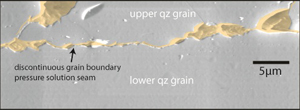| |||||||
|
|
|||||||
|
|
|||||||
| Initiation of Pressure Solution Seams | |||||||
|
Pressure solution seams, similar to joints and faults, are believed to initiate at flaws or heterogeneities in the rock at which significant enough stress concentrations occur (please see 'Mechanisms and Mechanics of Pressure Solution Seams,' and for a discussion of flaws and stress concentration, please refer to the section on 'Joint Initiation'). However, it is impossible to observe and identify the initiation points of pressure solution seams because, unlike the joints, pressure solution seams do not have any surface morphology indicating the initiation point of the structure. Furthermore, it takes several months to produce pressure solution in rock in the laboratory and, once it forms, the structure demolishes its path. It is however reasonable to envisage that the Intergranular Pressure Solution starts from the most favorable grain boundary. Considering that grain boundaries are not perfectly planar nor perfectly smooth, it follows that the process may start at a contact asperity along the most favorable grain boundary. Figure 1 shows a Secondary Electron Image of an initial stage of an inter-granular pressure solution seam between two interpenetrating quartz grains, which can be characterized as isolated pockets of clay (illite) distributed along the boundary. This geometry suggests that the dissolution along grain boundaries is not uniform but it is difficult to pinpoint the specific asperity at which the process started. Please see 'Growth of Pressure Solution Seams' for further details. | |||||||
|
Readme | About Us | Acknowledgement | How to Cite | Terms of Use | Ⓒ Rock Fracture Knowledgebase |
|||||||
